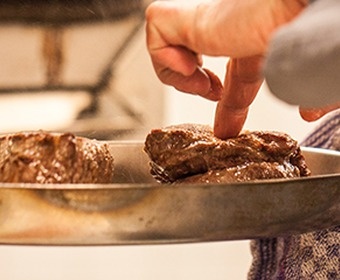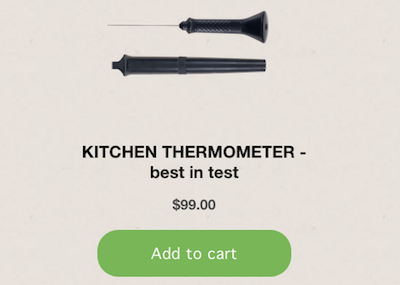
How to fry meat
- Always dry meat before searing it
- Too much in the pan at once and the meat will boil in its own juices
- Mixing oil and butter (in that order) is recommended
- Wait for caramelisation to make the meat come loose
- Let the meat rest after cooking
Frying meat is easy. Getting a perfect result can, however, be a lot trickier. All experienced meat chefs sy the same thing: Small details in handling make all the difference.
Before the pan
Always dry the meat before frying it, otherwise the surface will boil rather than sear. Don't put too much meat in the pan to avoid (1) the pan loosing heat and (2) the meat cooking in its own juices.
Cooking causes connective tissue inside the meat to shrink. Cut away – or cut through – any visible membranes before frying. You can also make incisions in covering fat to stop the meat from bending or twisting due to the applied heat.
Some chefs prefer butter, which adds flavor and gives you hints about the temperature in your pan. Others use oil, which is not affected by high temperatures. Some use a mix of both. Butter and olive oil make a very tasty mix, but both of them go badly with high temperatures. Experiment in your kitchen and find your own truth.
In the pan
Wait for caramelisation to occur on the surface of the meat so that it comes loose from the frying surface all by itself. Carefully try lifting it. If it is still stuck, wait a little more. If it comes loose after a while, caramelisation will have occurred.
The distribution of heat will be more even if you use a lot of fat when frying – but make sure not to boil the meat in butter or oil. Unless the meat has been breaded, you don't have to worry about the meat picking up fat. Breadcrumbs absorb large amounts of fat, while a coating of ordinary flour will result in a surface containing less fat.
Don't flip the meat too often while frying, or the pan's surface will take time to reheat over and over again. When juices start oozing out of the top of the meat it is time to flip it. Frying the second side always takes less time.
The heat takes 4 times longer to penetrate a slice of meat that is twice as thick. This goes for fish, potatoes and vegetables, too.
After the pan
It's agood idea to let residual heat do the job in a warm oven and using a thermometer, not least if the cut of meat has some thickness. Thinner cuts will also turn out perfect if you fry the meat in a pan and then place the pan in a moderately hot oven. Keep watch using a thermometer.
To get an even internal temperature and a pefect result, let the meat rest for 10 to 15 minutes after cooking. In this phase temperatures and juices become evenly distributed and the meat is "unstressed" before serving. This is important when meat has been cooked at high temperatures.
Dry frying
This means what it sounds like, frying meat in a dry and hot pan. The result is a harder and more uneven surface.
Wok and sauteuse
Using a wok is the Asian version of using a sauteuse. Ingredients cut into equal sized morcels – which all take roughly the same short time to cook – are tossed and fried with haste in a pan with a rounded bottom. A "mise en place" with the pre-cut ingredients is a must, there is no time for peeling and cutting when the wok/sauteuse is in action.
A wok must be so hot that the meat sears and vegetables heat up quickly without going soft, that is why a traditional wok is good for only two portions – maximum – at a time.
Dry the meat. Heat up the pan first, then add the oil. Use a high temperature.The oil must be heat resistant, virgin olive oil will not do. Introduce the raw materials according to the time they take to cook, whatever takes longer goes first.
If it stops sizzling, take out the meat and wait for the pan to heat up again.
Maillard for flavor
Creating a seared surface in a pan, in the oven or on a grill gives rise to more and bigger aromas and flavors. They are produced when proteins and carbohydrates combine and form flavor molecules in hundreds of different combinations. This effect only occurs when the surface of the meat is dry, the temperature must therefore be above boiling point. The phenomenon is known as the Maillard effect.
Flavors are also added through changes in fat molecules in the oil and butter you are using.



